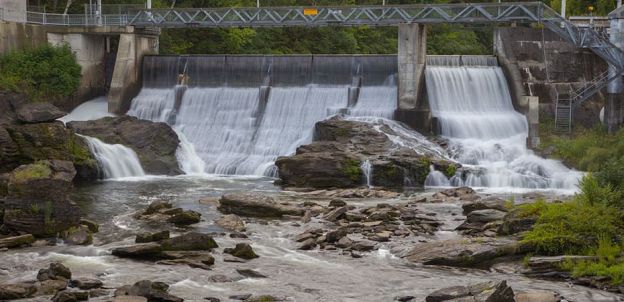As awareness of the climate emergency continues to grow amid events such as the record heat waves seen in the summer of 2023 or the series of devastating wildfires, many countries are stepping up their investments in the energy transition with a focus on clean energy sources. Despite its favourable position thanks to its early adoption of hydroelectric power, Québec does not intend to rest on its laurels: the province plans to ramp up its efforts to achieve carbon neutrality by 2050.

Hydro-Québec's recently published Action Plan 2035: Towards a Decarbonized and Prosperous Québec (the Action Plan) is aligned with those efforts insofar as this Québec government corporation plays a pivotal role in terms of the province's decarbonization and economic stimulus plans.
For Hydro-Québec, decarbonization will require a major push towards electrification, which means significantly higher electricity demand. By 2035, Hydro-Québec plans to add 60 TWh (between 8,000 and 9,000 MW) of additional power.
The goal is to tackle two major challenges: completing the energy transition and meeting consumers' needs. This ambitious project is divided into five priority areas summarized below.
Priority #1: Improving service quality
Climate change is putting the resilience of Hydro-Québec's facilities to the test, requiring investments to be increased to ensure reliable service. Accordingly, the Action Plan aims to reduce outages by 35 per cent in the next 7 to 10 years, with investments of $45 to $50 billion by 2035 aimed in particular at strengthening the power grid and addressing vegetation issues. That represents investments of $4 to $5 billion per year on average, nearly double the level of long-term investment over the past three years.
Hydro-Québec also plans to speed up the processing of electricity connection requests while improving the consumer experience. The main goal is to offer a service that is more reliable, straightforward and affordable.
Priority #2: Encouraging energy efficiency
Hydro-Québec also commits to encouraging more efficient electricity consumption. The objective is to double its customers' energy savings by 2035, freeing up 1,600 to 1,800 MW of additional power (for a total of 3,500 MW). This will help meet growing electricity demand. Initiatives include creating a dedicated team to offer personalized advice to all clients, financial incentives for the installation of high-efficiency equipment and flexible rate options aimed at shifting consumption outside of winter peak periods.
Despite these investments, Hydro-Québec is pinning its hopes on a more flexible rate structure, under which increases for residential customers would be capped at 3 per cent. For industrial and commercial rates, the focus will be on maintaining Québec's competitive position.
The overriding objective is to raise awareness of more efficient consumption and to create incentives to achieve these goals.
Priority #3: Increasing the power generation capacity
Recognizing that optimized and reduced consumption will not be enough to meet growing electricity demand during the energy transition, Hydro-Québec plans to increase its production capacity significantly by continuing to focus on hydroelectricity, wind power and exploring other options.
Commitments include tripling its wind power production capacity to meet needs totalling 1,500 to 1,700 MW. Hydro-Québec aims to incorporate more than 10,000 MW in new wind power capacity by 2035. This additional capacity represents more than $30 billion in private and public investments.
Hydroelectric power will complement wind power production as well. Plans for improved hydroelectric power production include increasing the power of existing generating stations by 3,800 to 4,200 MW and the development of new hydropower facilities, including pumped storage facilities. Investments totalling $35 to $45 billion are planned to provide additional hydroelectric capacity.
Emphasis will also be placed on solar energy and battery storage. In addition, there is the possibility that TransCanada Energy's existing thermal power plant may be converted to renewable natural gas to meet peak periods needs. Hydro-Québec also plans to explore other emerging energy sources worldwide and is even mulling its nuclear power options.
To maximize access to this new output, investments totalling $45 to $50 billion are expected in the transmission network, with more transparent planning enabling market actors to better organize their own activities as they will know which areas have available capacity. Hydro-Québec's President and CEO, Michael Sabia's recent speech to the Chamber of Commerce of Metropolitan Montreal discussed the construction of approximately 5,000 km of transmission lines. On average, investments aimed at meeting additional power demands range from $7 to $9 billion per year for the required assets in terms of production, transmission and distribution.
Priority #4: Partnering with Indigenous communities
Having acknowledged the impacts of past projects on Indigenous territories, Hydro-Québec commits to achieving economic reconciliation with the First Nations and the Inuit. Related efforts include creating financial partnerships aimed at facilitating the economic participation of Indigenous communities in new energy projects during all phases, from design to operation.
Priority #5: Becoming an agile, innovative and transparent organization
To reach the goals of decarbonization and economic growth, Hydro-Québec recognizes the need to transform its methods. Commitments include creating a center of expertise in collaboration with the Government of Québec to draw up a roadmap, collaborating with external partners to rapidly integrate innovations with a view to achieving its ambitions faster, and streamlining its practices and governance.
All told, these ambitious commitments to implement the Action Plan add up to between $155 and $185 billion by 2035 (an average of $12 to $16 billion per year). These investments are expected to generate major economic benefits for Québec, mobilizing an estimated workforce of 35,000 construction workers.
According to Hydro-Québec, adjustments to the legislative and regulatory frameworks will be necessary to facilitate the energy transition, particularly towards more flexible energy supply processes and simplified processes for granting government permits. A targeted dialogue with stakeholders, including Indigenous communities, municipalities, energy sector experts and other stakeholder groups (business, unions, environmental and construction sector), as well as with consumer representatives, will take place from November 2023 to March 2024. The findings will be presented in the spring of 2024.
Hydro-Québec's Action Plan 2035 and the accompanying Highlights sheet are both available online.
Read the original article on GowlingWLG.com
The content of this article is intended to provide a general guide to the subject matter. Specialist advice should be sought about your specific circumstances.



